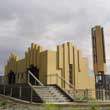Incinerators |

|
 |
|
The first Griffin and Nicholls incinerator
Walter Burley Griffin designed Leonard House for Nisson Leonard-Kanevsky in 1923–24. Griffin's Melbourne architectural office moved there in 1925 and the 'Griffin and Nicholls' office remained there until 1942. However, in August 1929 Leonard House also became the head office of the newly formed Reverberatory Incinerator and Engineering Company (RIECo) [pronounced Rye-Ko]. Leonard-Kanevsky had been persuaded to become its first Managing Director. This came about due to his friendship with another Russian immigrant, Vasilie Trunoff, who arrived in October 1928 with his wife and family to settle in Melbourne. Leonard-Kanevsky who had migrated from Russia prior to April 1916, became influential in the Jewish (Immigrant) Welcome Society, and was later chairman of the Jewish Land Settlement Trust. A Patent for 'Improvements to reverberatory incinerators' was lodged at the Commonwealth Patents Office on 22 July 1926, with John Boadle as actual inventor and sole applicant. Through a common interest in improving the method of incineration of garbage, John Boadle, then Sanitary Engineer for the Melbourne City Council, had met Vasilie Trunoff, also an incinerator engineer who had patented his invention for 'improvements to incinerators especially applicable for the destruction of garbage and night soil' on 1 February 1929. It was intended that the incinerator would be especially, but not exclusively, for the destruction of household garbage. In fact, RIECo type incinerators were later installed in the T & G Building in Sydney (1932) and in the crematorium at the Springvale Necropolis, Victoria (1937). The Trunoff Patent and the Boadle Patent formed the basis for the incorporation of the Reverberatory Incinerator and Engineering Company Pty Ltd on 19 August 1929. The Company was destined to survive the 1929 Economic Depression and rapidly became the most successful municipal incinerator company in Australia, maintaining that status for the next decade.
The first Griffin and Nicholls incinerator
|
TOP: Glebe Incinerator, Sydney restored and reinterpreted in 2006. Walter Burley Griffin Society Inc. Collection. ABOVE: Willoughby Incinerator, Sydney photographed shortly after completion, c.1935. Of the seven Griffin and Nicholls incinerators that were built in Sydney, only Willoughby and Glebe incinerators survive. Walter Burley Griffin Society Inc. Collection.
|
|||||||||||||||||||||||||||||||||||||||||||||||||||||||||||||||||||||||||||||||
Shortly before the incorporation of the Reverberatory Incinerator and Engineering Company, the Essendon City Council [Victoria] decided to construct an incinerator in Holmes Road, Moonee Ponds. The site selected, situated as it was adjacent to parkland and in close proximity to residential areas, demanded a building which would, as far as possible, harmonise with its surroundings. There had been considerable heated debate between the councillors of the municipality because none wanted a garbage incinerator in his ward. The design of a suitable building was made one of the requirements of the contract, which was awarded to the RIECo. It was therefore quite natural that Nisson Leonard-Kanevsky should ask Griffin to design a building to house the incinerator plant and at the same time provide a building of architectural merit that would be in keeping with the residential area. The inspiration for the design of the Essendon Incinerator building came from the Peters' Residence in Chicago that had been designed by Griffin in 1906. As Eric Milton Nicholls was architect-in-charge of Griffin's Melbourne Office in 1929 [Griffin moved to Sydney in 1924], it was he [Nicholls] who actually obtained the commission to design the building for the Essendon Incinerator. Another 12 Griffin and Nicholls incinerators When it was realised that there would be further commissions from RIECo for other incinerators, Griffin formed the partnership of Griffin and Nicholls which continued to practise in Melbourne and Sydney for some years after Griffin's death in 1937. It is believed that a formal partnership document was never drawn up. The association between the Griffin and Nicholls partnership and RIECo continued until 1942. The Canberra Incinerator was the last built to the design of Griffin and Nicholls in 1938.
|
ABOVE: Thebarton Incinerator, Adelaide, 1937. Photograph courtesy of the State Library of South Australia. B9690. |
|||||||||||||||||||||||||||||||||||||||||||||||||||||||||||||||||||||||||||||||
|
So successful was the reverberatory type of incinerator that in 1940 RIECo proudly proclaimed that its firm had installed every municipal incinerator in the Commonwealth of Australia, with the exception of two, in the preceding ten years. During that time 18 incinerators had been constructed, and the 13 of them designed by Griffin and Nicholls had each been individually designed to suit its site and the size of the incinerator plant specified.
AUTHOR: Peter Y Navaretti, an architectural historian, is a heritage adviser within the Australian Public Service. After 25 years of private research on the Griffins and later working as a Research Associate at the University of Melbourne, Peter co-edited with Dr Jeff Turnbull The Griffins in Australia and India: the complete works and projects of Walter Burley Griffin and Marion Mahony Griffin. This was the culmination of a lifelong ambition.
FURTHER READING: Kruty, Paul, 'Creating a Modern Architecture for India', in Anne Watson (ed) Beyond architecture: Marion Mahony and Walter Burley Griffin in America, Australia, India. Sydney, Powerhouse Publishing, 1998 pp138–159. Navaretti, Peter Y, 'The Pyrmont Incinerator and its Precedents', in Anne Watson (ed) Beyond architecture: Marion Mahony and Walter Burley Griffin in America, Australia, India. Sydney, Powerhouse Publishing, 1998 pp160–175. Navaretti, Peter Y. 'Essendon Incinerator', in Historic Environment, Vol.1: 3, 1981. Turnbull, Jeff and Navaretti, Peter Y (eds), The Griffins in Australia and India: the complete works and projects of Walter Burley Griffin and Marion Mahony Griffin. Melbourne, Miegunyah Press (Melbourne University Press), 1998. Walker, Meredith and Waters, Trevor. The former Willoughby Incinerator and Sewage Dump A report for Willoughby City Council, 2001. |
LEFT: Pyrmont Incinerator, Sydney. Photograph courtesy Powerhouse Museum. | |||||||||||||||||||||||||||||||||||||||||||||||||||||||||||||||||||||||||||||||
© 2006 - 2017 Walter Burley Griffin Society Inc. website terms of use